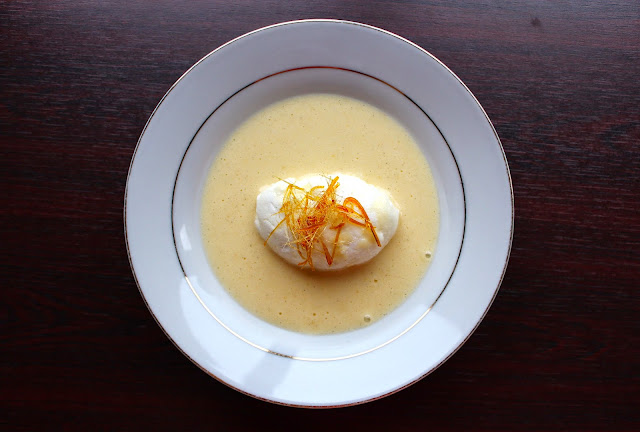When making their signature bakes - trifles - at the beginning of the episode Deborah accidentally used Howard's custard instead of her own, and not only did it ruffle feathers in the tent and cause a bit of a commotion, but it ushered in an entirely new era on the show. Custard-gate overtook the weather as the main topic of conversation in Britain that week, and I like to believe that it's heart-racing and deliciously tense episodes like this that elevated GBBO to BBC1 for the following series.
In amongst all the custard excitement at the start of the episode it's ridiculously easy to forget what on earth happened in the rest of it. The Technical Challenge was Mary Berry's Floating Islands, a "classy, dreamy dessert" that features quenelles of poached meringue floating on top of custard and decorated with a ball of spun sugar. Don't worry, I hadn't heard of them before the episode either.
Easy peasy? Not. At. All.
Ingredients:
For the crème anglaise:
300ml whole milk
300ml double cream
1 tsp vanilla bean paste
6 free-range eggs, yolks only
100g caster sugar
For the meringues:
6 free-range eggs, whites only
150g caster sugar
For the spun sugar:
100g caster sugar
To prepare the poaching liquid (and what will become the crème anglaise), heat the milk and cream in a large lidded pan or deep-sided frying pan. I really struggled to find a pan big enough, but after sending my mum up to rummage around in the loft she found this absolutely enormous pan. It's 27cm in diameter, took up almost all of the hob, and weighs about the same as a baby elephant. However, it did manage to fit all the 'islands' of meringue comfortably, so look for something of a similar size. If you only have a pan slightly smaller, then I'm sure it'd work well enough, you'd just have to settle for fewer islands.
Stir in the vanilla bean paste and bring to a simmer over a low heat.
For the meringues, in a large grease-free bowl use an electric hand whisk (or a free-standing electric mixer) to whisk the egg whites together on fast speed, until stiff peaks form when the whisk is removed.
Add one tablespoon of the sugar to the egg whites and continue to whisk until the mixture comes back to stiff peaks.
Keep adding sugar one tablespoon at a time until 150g has been used, and the meringue is thick and glossy.
Using two large tablespoons or serving spoons dipped in cold water, shape six large quenelles from the meringue mixture and place in the poaching liquid. I had no idea what a quenelle was when I first read the recipe, and absolutely no idea how to make one. I found this YouTube video pretty helpful, although it's for ice-cream and not meringue… I ended up sort of using that technique and also frantically trying to shape the meringue with another spoon. I'm no expert by any means so it was all a bit sloppy!
Place over a very low heat for about 9-10 minutes, flipping the quenelles halfway through. Cover the pan with a lid while poaching. Make sure the poaching liquid doesn’t boil or the meringues will puff up then collapse.
When the quenelles are really puffed up and cooked, transfer them to a wire rack to drain.
For the crème anglaise, pass the poaching milk through a sieve into a large jug (this removes all of the bits of meringue that broke off the islands during removal…).
In a large bowl, whisk the egg yolks and caster sugar together until pale and fluffy. Pour over the warm poaching milk, whisking continuously. Pour the mixture into a clean heavy-based pan and cook over a very low heat for 3-4 minutes stirring continuously until smooth and thick enough to coat the back of a spoon. Remove from the heat and set aside. This is the crème anglaise.
For the spun sugar, melt the sugar, without stirring, in a small stainless steel pan over a medium heat. Grease a rolling pin or knife steel with oil. Take care as the sugar will be very hot. When it turns a dark golden-brown remove from the heat, leave to cool slightly, then, using the back of a fork, flick the caramel backwards and forward over the rolling pin or knife steel. Gather the strands into rough ball shape and place on a sheet of parchment paper. I'm absolutely rubbish at this, so although I managed to make about one shoddy looking ball of sugar, the rest was thicker and rock hard!
To serve, pour a little crème anglaise into each serving bowl and float a quenelle of meringue on top. Decorate the quenelle with a ball of spun sugar.
I'm really not happy with the sugar work on top, and some of the meringues were really, really untidy shape-wise, but apart from that I'm quite pleased! I'd never even heard of Floating Islands before, and I have to admit they look pretty impressive. They went down extremely well at home - apparently the meringue just melted in the mouth and the custard was beautifully creamy. I thought the whole thing was a bit of a disaster as I was making them and was ready to give it all up as a bad job before I assembled them, but obviously I was prematurely disappointed!
As good as these look they were such a faff to make so I doubt I'll be doing them again. They'd be perfect for a dinner party though, and were excellent served cold - so maybe better in the summer?
Have you ever made these before? Are you planning on making them now? Do let me know in the comments below!

















No comments:
Post a Comment